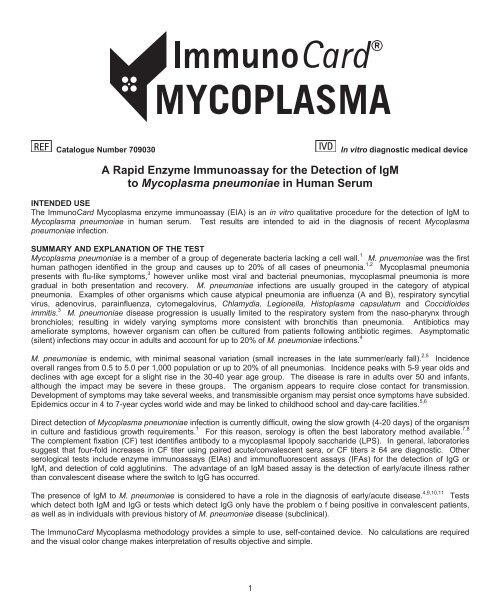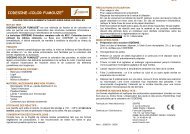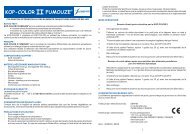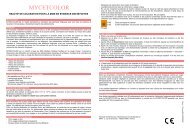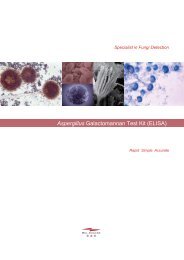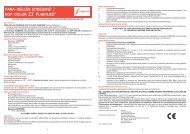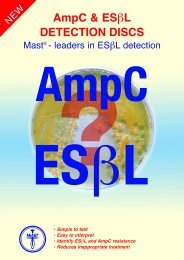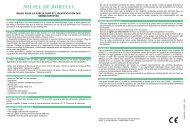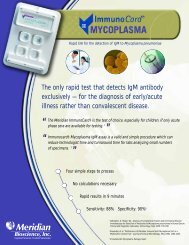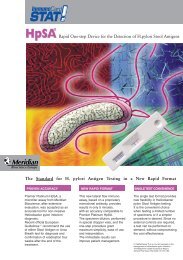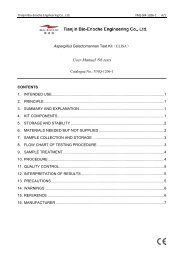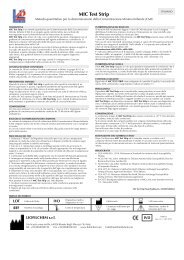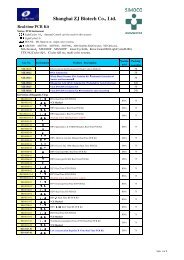A Rapid Enzyme Immunoassay for the Detection of IgM to ...
A Rapid Enzyme Immunoassay for the Detection of IgM to ...
A Rapid Enzyme Immunoassay for the Detection of IgM to ...
You also want an ePaper? Increase the reach of your titles
YUMPU automatically turns print PDFs into web optimized ePapers that Google loves.
Catalogue Number 709030In vitro diagnostic medical deviceA <strong>Rapid</strong> <strong>Enzyme</strong> <strong>Immunoassay</strong> <strong>for</strong> <strong>the</strong> <strong>Detection</strong> <strong>of</strong> <strong>IgM</strong><strong>to</strong> Mycoplasma pneumoniae in Human SerumINTENDED USEThe ImmunoCard Mycoplasma enzyme immunoassay (EIA) is an in vitro qualitative procedure <strong>for</strong> <strong>the</strong> detection <strong>of</strong> <strong>IgM</strong> <strong>to</strong>Mycoplasma pneumoniae in human serum. Test results are intended <strong>to</strong> aid in <strong>the</strong> diagnosis <strong>of</strong> recent Mycoplasmapneumoniae infection.SUMMARY AND EXPLANATION OF THE TESTMycoplasma pneumoniae is a member <strong>of</strong> a group <strong>of</strong> degenerate bacteria lacking a cell wall. 1 M. pnuemoniae was <strong>the</strong> firsthuman pathogen identified in <strong>the</strong> group and causes up <strong>to</strong> 20% <strong>of</strong> all cases <strong>of</strong> pneumonia. 1,2 Mycoplasmal pneumoniapresents with flu-like symp<strong>to</strong>ms, 3 however unlike most viral and bacterial pneumonias, mycoplasmal pneumonia is moregradual in both presentation and recovery. M. pneumoniae infections are usually grouped in <strong>the</strong> category <strong>of</strong> atypicalpneumonia. Examples <strong>of</strong> o<strong>the</strong>r organisms which cause atypical pneumonia are influenza (A and B), respira<strong>to</strong>ry syncytialvirus, adenovirus, parainfluenza, cy<strong>to</strong>megalovirus, Chlamydia, Legionella, His<strong>to</strong>plasma capsulatum and Coccidioidesimmitis. 3 M. pneumoniae disease progression is usually limited <strong>to</strong> <strong>the</strong> respira<strong>to</strong>ry system from <strong>the</strong> naso-pharynx throughbronchioles; resulting in widely varying symp<strong>to</strong>ms more consistent with bronchitis than pneumonia. Antibiotics mayameliorate symp<strong>to</strong>ms, however organism can <strong>of</strong>ten be cultured from patients following antibiotic regimes. Asymp<strong>to</strong>matic(silent) infections may occur in adults and account <strong>for</strong> up <strong>to</strong> 20% <strong>of</strong> M. pneumoniae infections. 4M. pneumoniae is endemic, with minimal seasonal variation (small increases in <strong>the</strong> late summer/early fall). 2,5 Incidenceoverall ranges from 0.5 <strong>to</strong> 5.0 per 1,000 population or up <strong>to</strong> 20% <strong>of</strong> all pneumonias. Incidence peaks with 5-9 year olds anddeclines with age except <strong>for</strong> a slight rise in <strong>the</strong> 30-40 year age group. The disease is rare in adults over 50 and infants,although <strong>the</strong> impact may be severe in <strong>the</strong>se groups. The organism appears <strong>to</strong> require close contact <strong>for</strong> transmission.Development <strong>of</strong> symp<strong>to</strong>ms may take several weeks, and transmissible organism may persist once symp<strong>to</strong>ms have subsided.Epidemics occur in 4 <strong>to</strong> 7-year cycles world wide and may be linked <strong>to</strong> childhood school and day-care facilities. 5,6Direct detection <strong>of</strong> Mycoplasma pneumoniae infection is currently difficult, owing <strong>the</strong> slow growth (4-20 days) <strong>of</strong> <strong>the</strong> organismin culture and fastidious growth requirements. 1 For this reason, serology is <strong>of</strong>ten <strong>the</strong> best labora<strong>to</strong>ry method available. 7,8The complement fixation (CF) test identifies antibody <strong>to</strong> a mycoplasmal lipopoly saccharide (LPS). In general, labora<strong>to</strong>riessuggest that four-fold increases in CF titer using paired acute/convalescent sera, or CF titers 64 are diagnostic. O<strong>the</strong>rserological tests include enzyme immunoassays (EIAs) and immun<strong>of</strong>luorescent assays (IFAs) <strong>for</strong> <strong>the</strong> detection <strong>of</strong> IgG or<strong>IgM</strong>, and detection <strong>of</strong> cold agglutinins. The advantage <strong>of</strong> an <strong>IgM</strong> based assay is <strong>the</strong> detection <strong>of</strong> early/acute illness ra<strong>the</strong>rthan convalescent disease where <strong>the</strong> switch <strong>to</strong> IgG has occurred.The presence <strong>of</strong> <strong>IgM</strong> <strong>to</strong> M. pneumoniae is considered <strong>to</strong> have a role in <strong>the</strong> diagnosis <strong>of</strong> early/acute disease. 4,9,10,11 Testswhich detect both <strong>IgM</strong> and IgG or tests which detect IgG only have <strong>the</strong> problem o f being positive in convalescent patients,as well as in individuals with previous his<strong>to</strong>ry <strong>of</strong> M. pneumoniae disease (subclinical).The ImmunoCard Mycoplasma methodology provides a simple <strong>to</strong> use, self-contained device. No calculations are requiredand <strong>the</strong> visual color change makes interpretation <strong>of</strong> results objective and simple.1
PRINCIPLE OF THE TESTThe ImmunoCard Mycoplasma EIA detects <strong>the</strong> presence <strong>of</strong> <strong>IgM</strong> <strong>to</strong> M. pneumoniae in serum. Patient serum is added <strong>to</strong> each<strong>of</strong> <strong>the</strong> two sample ports. After allowing <strong>the</strong> sample <strong>to</strong> enter <strong>the</strong> device and migrate along <strong>the</strong> membrane and through <strong>the</strong>reaction ports, three drops <strong>of</strong> anti-human <strong>IgM</strong> alkaline phosphatase conjugate are added <strong>to</strong> <strong>the</strong> sample ports and allowed <strong>to</strong>enter <strong>the</strong> device. Three drops <strong>of</strong> wash and two drops <strong>of</strong> substrate are <strong>the</strong>n added <strong>to</strong> each <strong>of</strong> <strong>the</strong> reaction ports. Reactionports are observed <strong>for</strong> <strong>the</strong> development <strong>of</strong> any blue color after five minutes. The CONTROL port serves as a proceduralcontrol, containing immobilized human <strong>IgM</strong> in <strong>the</strong> reaction port. The TEST port contains M. pneumoniae antigens andserves as <strong>the</strong> patient test port. The development <strong>of</strong> blue color in <strong>the</strong> TEST port indicates a reactive test result <strong>for</strong> <strong>IgM</strong> <strong>to</strong> M.pneumoniae. No blue color in <strong>the</strong> TEST port indicates a nonreactive result.REAGENTS/MATERIALS PROVIDED1. Test Cards - Individually foil pouched cards containing immobilized detergent extracted M. pneumoniae antigens(TEST reaction port) and human <strong>IgM</strong> (CONTROL reaction port)2. Positive Control - Sample containing human anti-M. pneumoniae <strong>IgM</strong> in a buffer containing 0.1% sodium azide3. Negative Control - Buffer containing 0.1% sodium azide4. <strong>Enzyme</strong> Conjugate - Monoclonal anti-human <strong>IgM</strong> labeled with alkaline phosphatase in a buffer containing 0.1%sodium azide5. Wash Buffer - Buffer containing 9.5% (weight/vol.) guanidine hydrochloride6. Substrate Reagent - Buffered solution containing 5-bromo-4-chioro-3-indolyl phosphate and 0.1% sodium azide7. Transfer PipettesThe maximum number <strong>of</strong> tests obtained from this test kit is listed on <strong>the</strong> outer box.MATERIALS NOT PROVIDEDTimerPRECAUTIONS1. All reagents are <strong>for</strong> in vitro diagnostic use only.2. Reagent concentration, incubation times and temperatures (22-25 C) have been optimized <strong>for</strong> sensitivity andspecificity. Best results are obtained by adhering <strong>to</strong> <strong>the</strong>se specifications. Once <strong>the</strong> assay has been started, completeall subsequent steps without interruption.3. The right reaction (upper) port has been coated with extracted Mycoplasma antigens. Handle as a potentiallyhazardous material.4. Patient specimens, Positive Control reagent, and used Test Cards may contain infectious agents and should behandled at Biosafety Level 2 as recommended in <strong>the</strong> CDC/NIH manual “Biosafety in Microbiology and BiomedicalLabora<strong>to</strong>ries”; 2007.5. The Positive Control contains human sera, which were screened <strong>for</strong> HBsAg and antibody <strong>to</strong> HIV-1 and found <strong>to</strong> benegative. However, no test can <strong>of</strong>fer complete assurance that human blood will not transmit HIV, hepatitis, or o<strong>the</strong>rinfectious agents.6. All reagents should be gently mixed and at 22-25 C be<strong>for</strong>e use.7. Do not interchange reagents from different kit lot numbers or use expired reagents.8. Hold reagent vials and transfer pipettes vertically <strong>to</strong> insure proper drop size and delivery. Do not allow <strong>the</strong> tips <strong>of</strong> <strong>the</strong>bottle or pipette <strong>to</strong> <strong>to</strong>uch ei<strong>the</strong>r <strong>the</strong> sample or reaction ports.9. Replace colored caps on correct vials.10. Substrate Reagent may be light sensitive and should not be exposed <strong>to</strong> excessive illumination. Substrate Reagentshould be colorless. If this reagent exhibits a blue color, it should be discarded.11. Use only one transfer pipette per control or specimen. Discard after use. Do not attempt <strong>to</strong> reuse.12. Disregard any color reactions in <strong>the</strong> sample (lower) ports. Results are determined by color development in <strong>the</strong> reaction(upper) ports.13. Severely lipemic serum, contaminated serum, or serum with excessive debris may restrict movement <strong>of</strong> <strong>Enzyme</strong>Conjugate in<strong>to</strong> <strong>the</strong> sample (lower) ports, potentially producing an invalid result. Noncontaminated serum causing flowproblems (invalid results) may be centrifuged and retested.14. Specimens with obvious microbial contamination or severe hemolysis should not be tested as <strong>the</strong>y may yield unreliableresults.15. Patient samples should not be allowed <strong>to</strong> dry in <strong>the</strong> sample application ports. Drying <strong>of</strong> whole blood or serum ont<strong>of</strong>ilter paper inactivates, <strong>to</strong> varying extents, <strong>IgM</strong> class antibodies. 12WARNING: Some reagents in this kit contain sodium azide which is a skin irritant. Avoid skin contact with reagents.Disposal <strong>of</strong> reagents containing sodium azide in<strong>to</strong> lead or copper plumbing can result in <strong>the</strong> <strong>for</strong>mation <strong>of</strong> explosivemetal azides. This can be avoided by flushing with a large volume <strong>of</strong> water during such disposal.2
RISK AND SAFETY PHRASESSubstrate, Negative Control, <strong>Enzyme</strong> Conjugate, Positive Control: HARMFUL – SODIUM AZIDERISK PHRASES:22 Harmful if swallowed32 Contact with acids liberates very <strong>to</strong>xic gasSTORAGE AND STABILITYThe expiration date is indicated on <strong>the</strong> kit label. S<strong>to</strong>re <strong>the</strong> kit at 2-8 C and return <strong>the</strong> kit promptly <strong>to</strong> <strong>the</strong> refrigera<strong>to</strong>r after eachuse.SPECIMEN COLLECTION AND PREPARATIONSerum specimens obtained from clotted blood should be s<strong>to</strong>red at 2-8 C until tested. The specimen should be tested assoon as possible but may be held up <strong>to</strong> 72 hours at 2-8 C prior <strong>to</strong> testing. If testing cannot be per<strong>for</strong>med within this timeframe, <strong>the</strong> specimen should be frozen in a nondefrosting freezer (-20 C or lower) immediately upon receipt. Repeatedfreezing and thawing <strong>of</strong> specimens should be avoided.REAGENT PREPARATION1. Allow all kit components <strong>to</strong> reach room temperature (22-25 C) be<strong>for</strong>e use (requires at least one hour). Gently mixliquid reagents prior <strong>to</strong> use.2. All reagents come ready <strong>to</strong> use (no dilution required)PROCEDURAL NOTES1. The Test Card <strong>for</strong>mat is diagrammed below:2. Batch processing any number <strong>of</strong> samples or controls is possible provided that <strong>for</strong> each card, <strong>the</strong> appropriate steps,sequence <strong>of</strong> reagent addition, incubation (wait) times and result reading time are maintained. Each procedural stepshould be completed with each sample be<strong>for</strong>e <strong>the</strong> next step is started.3. The CONTROL (left) side <strong>of</strong> each card provides a procedural control <strong>for</strong> each specimen. This tests <strong>for</strong> properspecimen and reagent flow characteristics as well as reagent per<strong>for</strong>mance.TEST PROCEDUREThis test should be per<strong>for</strong>med by qualified personnel per local regula<strong>to</strong>ry requirements.1. Remove <strong>the</strong> appropriate number <strong>of</strong> Test Cards from <strong>the</strong>ir envelopes. Label with appropriate identification. Use 1 TestCard <strong>for</strong> each control or sample <strong>to</strong> be tested.2. Using a transfer pipette, dispense 2 drops <strong>of</strong> serum <strong>to</strong> both lower sample ports.3. Incubate 2 minutes at 22-25 C. Note: during <strong>the</strong> 2-minute incubation, specimen must adsorb completely and coverboth reaction (upper) ports.4. Add 3 drops <strong>of</strong> <strong>Enzyme</strong> Conjugate <strong>to</strong> both sample (lower) ports. Incubate 2 minutes at 22-25 C. <strong>Enzyme</strong> Conjugateshould completely absorb during <strong>the</strong> incubation period.5. Add 3 drops <strong>of</strong> Wash Buffer <strong>to</strong> both reaction (upper) ports. Wait until wash buffer has absorbed completely.6. Add 2 drops <strong>of</strong> Substrate Reagent <strong>to</strong> both reaction (upper) ports. Start a timer <strong>for</strong> 5 minutes when substrate is added<strong>to</strong> <strong>the</strong> first Card. Incubate <strong>for</strong> 5 minutes at 22-25 C. Visually read results immediately at <strong>the</strong> end <strong>of</strong> <strong>the</strong> incubationperiod.3
INTERPRETATION OF RESULTSREACTIVE NONREACTIVE INVALIDREAD ONLY UPPER REACTION PORTS TO INTERPRET RESULTSReactive Test Result: Visually detectable blue color in BOTH reaction ports. Occasionally a reactive test result may showevidence <strong>of</strong> a gradation <strong>of</strong> blue color within <strong>the</strong> reaction port. A reactive result indicates <strong>the</strong> presence <strong>of</strong> <strong>IgM</strong> <strong>to</strong> M.pneumoniae.Nonreactive Test Result: Visually detectable blue color in CONTROL reaction port (upper left) only. The TEST reactionport (upper right) should be colorless <strong>to</strong> faint grey. Occasionally, <strong>the</strong> TEST reaction port (upper right) may show evidence <strong>of</strong>a hint <strong>of</strong> blue color in <strong>the</strong> right or left side <strong>of</strong> <strong>the</strong> port, with <strong>the</strong> rest <strong>of</strong> <strong>the</strong> port remaining colorless. This should be considereda nonreactive test result. Nonreactive results indicate ei<strong>the</strong>r <strong>the</strong> absence <strong>of</strong> <strong>IgM</strong> <strong>to</strong> M. pneumoniae, or levels below <strong>the</strong> limit<strong>of</strong> detection <strong>for</strong> <strong>the</strong> assay.Invalid Test Result: No detectable color in CONTROL reaction port (upper left). Invalid test results may be due <strong>to</strong> areagent/Test Card problem, a procedural error, or restriction <strong>of</strong> flow <strong>of</strong> sample and/or <strong>Enzyme</strong> Conjugate due <strong>to</strong> severelycontaminated. lipemic or debris containing serum. Noncontaminated serum may be centrifuged and retested.QUALITY CONTROLThe Positive and Negative Controls should be assayed upon receipt <strong>of</strong> <strong>the</strong> kit. Add two drops <strong>of</strong> Positive Control <strong>to</strong> bothlower Sample ports <strong>of</strong> a card. Add two drops <strong>of</strong> Negative Control <strong>to</strong> both lower Sample ports <strong>of</strong> a second card. Follow Steps3 through 6 in <strong>the</strong> Procedure Section.1. Positive Control: Must yield visually detectable blue color in both reaction (upper) ports.2. Negative Control: Must yield visually detectable blue color in CONTROL (upper left) reaction port only. The TEST(upper right) reaction port should be colorless.The Procedural Control present in <strong>the</strong> upper left port <strong>of</strong> each Test Card tests <strong>the</strong> individual specimen <strong>for</strong> proper flow andreagent per<strong>for</strong>mance. Failure <strong>of</strong> <strong>the</strong> Procedural Control <strong>to</strong> yield a blue color with any specimen or control reagent indicatesan invalid test result and <strong>the</strong> test should be repeated.At <strong>the</strong> time <strong>of</strong> each use, kit components should be visually examined <strong>for</strong> obvious signs <strong>of</strong> microbial contamination, freezing,or leakage.Repeat <strong>the</strong> control tests as <strong>the</strong> first step in determining <strong>the</strong> root cause <strong>of</strong> <strong>the</strong> failure.It is suggested that <strong>the</strong> results <strong>of</strong> each quality control check be recorded in an appropriate log book <strong>to</strong> maintain high qualitytesting records. If <strong>the</strong> expected reactions are not observed and <strong>the</strong> reagents are still within <strong>the</strong>ir expiration date, pleasecontact Meridian Bioscience’s Technical Support Services at 513-271-3700 or 800-343-3858 (<strong>for</strong> US only) or contact yourCountry/Local Distribu<strong>to</strong>r.EXPECTED VALUESThe ImmunoCard Mycoplasma test was evaluated at four hospitals throughout <strong>the</strong> midwest. In addition, a reference labtested specimens from throughout <strong>the</strong> country. Of <strong>the</strong> 160 prospective specimens tested at <strong>the</strong> hospital sites, 26 (16%) werepositive by <strong>the</strong> ImmunoCard Mycoplasma test. The reference labora<strong>to</strong>ry reported 85/352 (24%) ImmunoCard Mycoplasmapositive specimens. These results were consistent with results obtained using o<strong>the</strong>r <strong>IgM</strong> tests <strong>for</strong> M. pneumoniae, as well aspublished findings <strong>for</strong> <strong>the</strong> prevalence <strong>of</strong> <strong>IgM</strong> <strong>to</strong> M. pneumoniae. 1,2,13,14 When a group <strong>of</strong> blood bank sera was tested <strong>for</strong> <strong>IgM</strong><strong>to</strong> M. pneumoniae using <strong>the</strong> ImmunoCard Mycoplasma and a reference EIA, a prevalence <strong>of</strong> 12.7% and 16% was found byeach method, respectively.4
LIMITATIONS OF THE PROCEDURE1. ImmunoCard Mycoplasma test results should be used in conjunction with in<strong>for</strong>mation available from <strong>the</strong> patient clinicalevaluation and o<strong>the</strong>r available diagnostic procedures.2. Samples obtained <strong>to</strong>o early during infection may not contain detectable levels <strong>of</strong> <strong>IgM</strong> antibody. If a M. pneumoniaeinfection is suspected, a second sample should be obtained in 7-14 days and tested.3. Significance <strong>of</strong> test results <strong>of</strong> immunosuppressed patients may be difficult <strong>to</strong> interpret.4. Positive test results may not be valid in persons who have received blood transfusions or o<strong>the</strong>r blood products within<strong>the</strong> past several months.5. Specific <strong>IgM</strong> antibodies <strong>to</strong> M. pneumoniae are usually detected in patients with a recent primary infection. However,<strong>the</strong>y may be found in patients with reactivated or secondary infections and are sometimes found in patients with noo<strong>the</strong>r detectable evidence <strong>of</strong> recent infection. 7,11 In addition, <strong>IgM</strong> <strong>to</strong> M. pneumoniae has been shown <strong>to</strong> persist <strong>for</strong>extended periods (2-12 months) in some patients. 116. False negative results due <strong>to</strong> competition by high levels <strong>of</strong> lgG, while <strong>the</strong>oretically possible, have not been observed.SPECIFIC PERFORMANCE CHARACTERISTICSThe ImmunoCard Mycoplasma test was evaluated using sera at three hospitals and one reference labora<strong>to</strong>ry. ImmunoCardMycoplasma results were compared with a microwell EIA <strong>for</strong> <strong>IgM</strong> <strong>to</strong> M. pneumoniae. Discrepant results were resolved byIFA, latex and complement fixation testing.ImmunoCardReference EIAResolvedReactive Nonreactive Retest Reactive Nonreactive RetestReactive 69 45 16 88 29 13Nonreactive 27 245 12 12 268 4Relative Sensitivity 88% ± 6% 1Relative Specificity 90% ± 3%Relative Agreement 90% ± 3%1 ± values calculated as 95% confidence intervals using <strong>the</strong> normal method.Forty-five ImmunoCard Mycoplasma reactive specimens, which were nonreactive by <strong>the</strong> reference EIA had 14 reactive,26nonreactive, and five unresolved results. Sixteen sera with reactive ImmunoCard and indeterminate reference EIA resultshad five reactive, three nonreactive, and eight unresolved results.Twenty-seven specimens with lmmunoCard nonreactive, reference EIA reactive results had 11 reactive, 14 nonreactive, andtwo unresolved results. Finally, 12 lmmunoCard nonreactive, reference EIA indeterminate specimens had one reactive,nine nonreactive, and two unresolved results. No lmmunoCard Mycoplasma invalid test results were obtained during clinicaltrials compared <strong>to</strong> 28/414 or a 6.8% retest rate <strong>for</strong> <strong>the</strong> reference EIA method.Two <strong>of</strong> <strong>the</strong> clinical trial sites (one hospital and a reference lab) per<strong>for</strong>med complement fixation titration <strong>for</strong> antibody <strong>to</strong> M.pneumoniae. CF results were grouped as nonreactive (< 1/8), low (1/8-1/32), and reactive (1/64). ImmunoCardMycoplasma results were compared with CF titers in <strong>the</strong> table below.CF TiterImmunoCard < 8 8-32 64Reactive 29 25 28Nonreactive 97 56 4The ImmunoCard Mycoplasma test correctly identified 28/32 (88%) <strong>of</strong> <strong>the</strong> high titer ( 64) CF specimens. The ImmunoCardtest was reactive with 25 (31%) <strong>of</strong> <strong>the</strong> low titer CF (8-32) specimens. Twenty-four (96%) <strong>of</strong> <strong>the</strong>se were confirmed as <strong>IgM</strong>reactive by o<strong>the</strong>r methods. Finally, 25/29 (86%) CF nonreactive specimens were found reactive by ImmunoCardMycoplasma and were also reactive by ei<strong>the</strong>r EIA or IFA.5
ANALYTICAL SPECIFICITYThe specificity <strong>of</strong> <strong>the</strong> ImmunoCard Mycoplasma test was evaluated on retrospective specimens from patients with positiveculture or with serological evidence <strong>for</strong> o<strong>the</strong>r atypical pneumonias, as well as viral, bacterial, and fungal pneumonias.Specimens positive <strong>for</strong> rheuma<strong>to</strong>id fac<strong>to</strong>r, anti-nuclear antibody and lupus were also tested. One <strong>of</strong> four Iupus specimenswas ImmunoCard Mycoplasma reactive. No cross-reactions were observed with <strong>the</strong> o<strong>the</strong>r classes <strong>of</strong> sera listed below.Values in paren<strong>the</strong>ses indicate <strong>the</strong> number <strong>of</strong> sera tested.His<strong>to</strong>plasma (5) Cy<strong>to</strong>megalovirus (6) Coccidioides (10) Epstein Barr Virus (14)Parainfluenza 3 (1) Legionella (7) Influenza A (13) Chlamydia (9)Influenza B (1) Antinuclear Antibody (20) Respira<strong>to</strong>ry Syncytial Virus (1) Rheuma<strong>to</strong>id Fac<strong>to</strong>r (10)Adenovirus (3)ITALIANONumero di catalogo 709030Dispositivo medico-diagnostico in vitroTest rapido immunoenzimatico per la ricerca delle <strong>IgM</strong>anti-Mycoplasma pneumoniae nel sieroFINALITÀ D’USOL’ ImmunoCard Mycoplasma è un test immunoenzimatico (EIA) che consente la ricerca qualitativa in vitro delle <strong>IgM</strong> anti-Mycoplasma pneumoniae (MP) nel siero. I risultati di tale esame rappresentano un aiu<strong>to</strong> nella diagnostica delle infezioniacute o recenti causate da Mycoplasma pneumoniae.RIASSUNTO E SPIEGAZIONE DEL TESTMycoplasma pneumoniae appartiene ad un gruppo di batteri, i Mollicuti, caratterizzati dalla mancanza della parete cellulare. 1M. pneumoniae è sta<strong>to</strong> il primo componente di ques<strong>to</strong> gruppo ad essere identifica<strong>to</strong> come pa<strong>to</strong>geno umano ed attualmente èritenu<strong>to</strong> responsabile di una percentuale abbastanza consistente (fino al 20%) dei casi di infezioni polmonari. 1,2 Lapolmonite da Mycoplasma si presenta con una sin<strong>to</strong>ma<strong>to</strong>logia simile a quella dell’influenza, 3 tuttavia, a differenza dellamaggior parte delle polmoniti ad eziologia batterica e virale, essa è caratterizzata da unamaggiore gradualità, sianell’insorgenza dei sin<strong>to</strong>mi che nella guarigione. Le infezioni causate da M. pneumoniae vengono normalmente classificatetra le polmoniti atipiche, che raggruppano quelle indotte da un’ampia gamma di microrganismi, tra cui virus influenzale (A eB), Virus Respira<strong>to</strong>rioSinciziale, Adenovirus, Parainfluenza, Cy<strong>to</strong>megalovirus, Chlamydia, Legionella, His<strong>to</strong>plasmacapsulatum e Coccidioides immitis. 3 La diffusione dell’infezione da M. pneumoniae è normalmente limitata alla partedell’appara<strong>to</strong> respira<strong>to</strong>rio compresa tra la zona rin<strong>of</strong>aringea ed i bronchioli, con una conseguente sin<strong>to</strong>ma<strong>to</strong>logia mol<strong>to</strong>variabile, più simile aduna bronchite che non ad una polmonite. La terapia antibiotica può alleviare i sin<strong>to</strong>mi, tuttavia spessoè possibile isolare in coltura M. pneumoniae anche dopo il trattamen<strong>to</strong>. Nei pazienti adulti si possono osservare ancheinfezioni asin<strong>to</strong>matiche (silenti), con una percentuale che può arrivare anche al 20% del <strong>to</strong>tale di polmoniti da M.pneumoniae. 4 6


